Early model motorhomes were equipped with a 30 amp shore power circuit. When on shore power, it was easy to overload this circuit, especially if trying to run both air conditioners and other electrical loads. Running both A/C units on generator power was no problem, because the A/C units got their power from two separate circuits on the generator.
HOW IT WORKS.
SHORE POWER – To prevent overloading the 30 amp shore power circuit, Fleetwood used a heating and air condition controller from Intellitec ECC that detected amps being drawn by the 120 volt distribution panel. If the current draw through the panel was greater than about 25-28 amps, the ECC would “SHED” or turn off one of the compressor to keep power consumption through the panel below 30 amps.
GENERATOR POWER – When running on generator power, the generator has two separate circuits, a 30 amp circuit that feeds the normal 120 volt distribution panel loads, and a 20 amp Generator A/C circuit that feeds only the front A/C unit and nothing else.
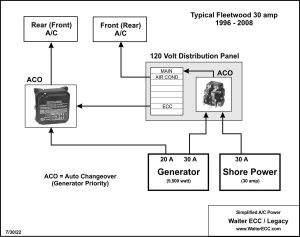 There are two automatic change over (ACO) solenoids in the system. One determines the power source for the main 120 power distribution panel and the other determines the power source for the front A/C unit.
There are two automatic change over (ACO) solenoids in the system. One determines the power source for the main 120 power distribution panel and the other determines the power source for the front A/C unit.
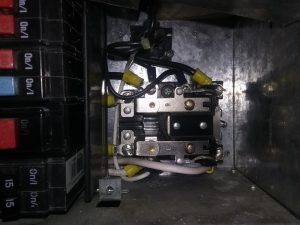
When the generator is running, the main 120 volt ACO senses voltage from the 30 amp generator circuit and after a short time delay, the ACO energizes and switches the 120 circuit breaker panel from shore power to generator power. (CLICK TO SEE MAIN ACO SOLENOID REPLACEMENT)
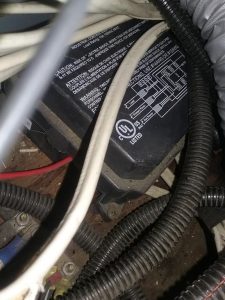
In a similar fashion, when the A/C’s ACO senses 120 volts coming from the generator’s 20 amp A/C circuit, it disconnects the front A/C unit from the 120 volt distribution panel and connects it to the 20 amp generator A/C circuit. NOTE: The original ACO was a 15 amp solenoid, Intellitec # 00-00568-000. Replace it with the 30 amp version, Intellitec # switch, 00-00638-000
MODIFIED SHORE POWER CONNECTIONS
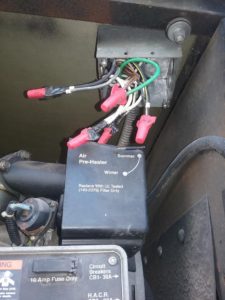 This modification takes advantage of the fact that the front A/C unit can automatically run on a dedicated generator 20 amp circuit. We do this by tricking the front A/C ACO into thinking that the generator is supplying power, when in fact, that power is being supplied by an extension cord plugged into a pedestals 20 amp circuit
This modification takes advantage of the fact that the front A/C unit can automatically run on a dedicated generator 20 amp circuit. We do this by tricking the front A/C ACO into thinking that the generator is supplying power, when in fact, that power is being supplied by an extension cord plugged into a pedestals 20 amp circuit
This modification is reasonably simple for any DIY’er who has some basic home wiring skills..
In my generator compartment, the 20 and 30 amp generator circuit wires go into a junction box where the wires get spliced into the wires that go up through the floor and into the motorhome. The A/C unit wires use a #14 wire and the 30 amp wires are #12.
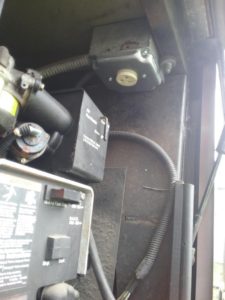 I disconnected these A/C wire (#14) splice wire nuts and installed a receptacle and plug. I attached the wires from the generator to a new heavy duty 120 volt receptacle. I then made a 2 ft long pigtail with #12 cord; on one end was a heavy duty 120 volt plug, the other end went inside the junction box where I used wire nuts to connect the pig tail ends to the #14 wires that went up through the floor.
I disconnected these A/C wire (#14) splice wire nuts and installed a receptacle and plug. I attached the wires from the generator to a new heavy duty 120 volt receptacle. I then made a 2 ft long pigtail with #12 cord; on one end was a heavy duty 120 volt plug, the other end went inside the junction box where I used wire nuts to connect the pig tail ends to the #14 wires that went up through the floor.
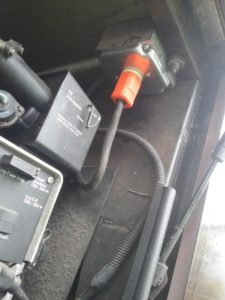 Normally, the newly installed A/C unit plug stays connected to the new generator receptacle. If I’m on shore power and want to run the front A/C unit without the shedding, I unplug the front A/C unit from the generator and using a #12 extension cord, plug the front A/C unit into the pedestals 20 amp circuit. The A/C AOC now detects 120 volts from what it thinks is the generator. It then automatically disconnects the front A/C from the 120 distribution panel and connects to the generator circuit.
Normally, the newly installed A/C unit plug stays connected to the new generator receptacle. If I’m on shore power and want to run the front A/C unit without the shedding, I unplug the front A/C unit from the generator and using a #12 extension cord, plug the front A/C unit into the pedestals 20 amp circuit. The A/C AOC now detects 120 volts from what it thinks is the generator. It then automatically disconnects the front A/C from the 120 distribution panel and connects to the generator circuit.
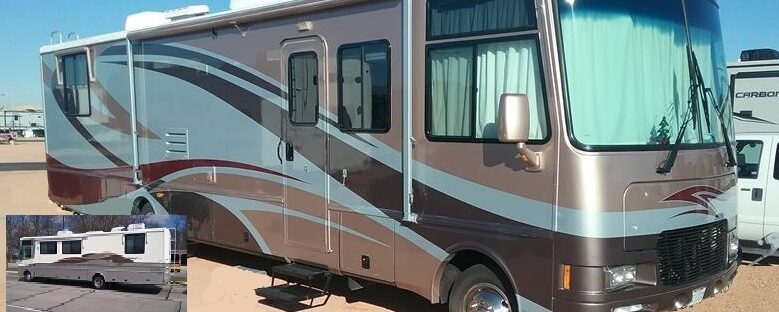
I have a ’99 Bounder 34J that is very similar to your Southwind. I would love to make this modification to my unit. However, when it comes to things electrical, I don’t have a clue. It appears to be an easy fix but it’s like my Dad always said. It’s easy if you know how. I wish I knew how to do it because the way it works is a real problem.
Great write up! I’m going to try to duplicate what you did on my motorhome, a 2000 Hurricane with a 30 amp panel and 2 ac’s. Question: my rig has a selector switch to choose which ac to use when on shore power. If yours has this selector, switch which position is it in? Does it matter which position? Thanks.
Mine doesn’t have a manual selector switch. I have a Electronic Climate Control (ECC) system (fancy name for thermostat) that controls both A/C units and furnaces.. It allows both A/C units to run, but monitors the shore power current. If the current exceeds 30 amps, it turns off one of the compressors off.
I updated the 20 year old ECC with a new modern unit. (You may be interested in taking a look.
https://waiterecc.com/
I knew this was a possibility and I think you very much for already doing the work and documenting! I will be doing this myself very soon. It’s so HOT in FL right now that I could only run the cloths drier at night!
Completed this and it works well. Two A/Cs thru the 30A will regularly trip the 30A breaker on the post.
One difference on mine — my electrical box is rotated 90deg, so the receptacle faces the compartment door. This leaves less space for the plug to fit, so I had to use a right angle plug. Search “appliance extension cord”; most have a right angle plug for fitting in tight spaces.
PERFECT — Thanks for reporting back.
I thought of this myself, and bought the parts, but you know about the elusive round tuit. An added bonus to this is that you now have a ready made standby generator for your house. All you have to do is pull the plug and insert your extension cord and run it to the house. It takes a little creativity, but it’s no harder to do than what you describe here. The national electrical code requires a transfer switch at your breaker box if you want to activate the outlets in your house, but at a minimum if you don’t want to go through that, you can just run an extension cord with multiple outlets to plug in your refrigerator, some lights, and a TV and hope the power comes on soon.
Yes, a cord with a male plug on both sides, we call this a suicide cord.
I live out in the country where we lose power several times a year. I have a small 1kw generator for these emergencies. I installed a few outlets near key items, frig, furnace, TV, and one outside.. These are all wired together, but are not connected to the houses power. If I know I’m going to be without power, I’d drag out the small genny, use the suicide cord to plug it into the outside outlet, and I could runt these key items.
Of course now that I have more capacity if I use the motorhome 5.5kw, I could run more loads. I may install a safety cover on my main house feed panel so I can switch between the commercial and generator power.
I did that myself on a home I owned previously. You have to be careful to turn off your main breakers when you make this type of connection because not only are you making your outlets hot, but also the power grid you’re connected to. It’s likely that there are linemen out working on those lines that you’ve made hot, and there is a real danger of electrocuting one of them. That’s why the NEC prohibits this kind of connection without an automatic transfer switch.
Does a soft start help with the AC/30amp process. I know they use this for solar to cut down on the initial power kick needed to turn over the compressor(s). It seems this may give your ac’s more ability to cool the way your setting up for 50 amp bby 30 and 20 amp seperate sources?
I did it. works great. no more shed during the hot time of day. both ac units running full time
This is a great idea, I hope to make this modification soon to my 2002 Southwind. We were in Vegas last summer and the one ac could not keep up to say the least.
Thanks for the great instructions.
Chris
I finally completed this modification. It works great! Finally we can keep cool with both AC’s on when hooked up to shore power. Thanks again for the great write-up and pictures!
Steve,
What year and model is your rig?
Thanks,
Wayne S.
2000 Hurricane 29D Workhorse